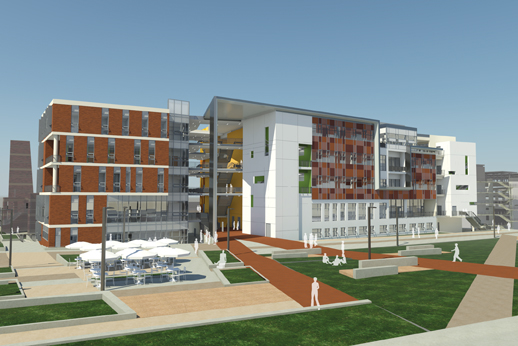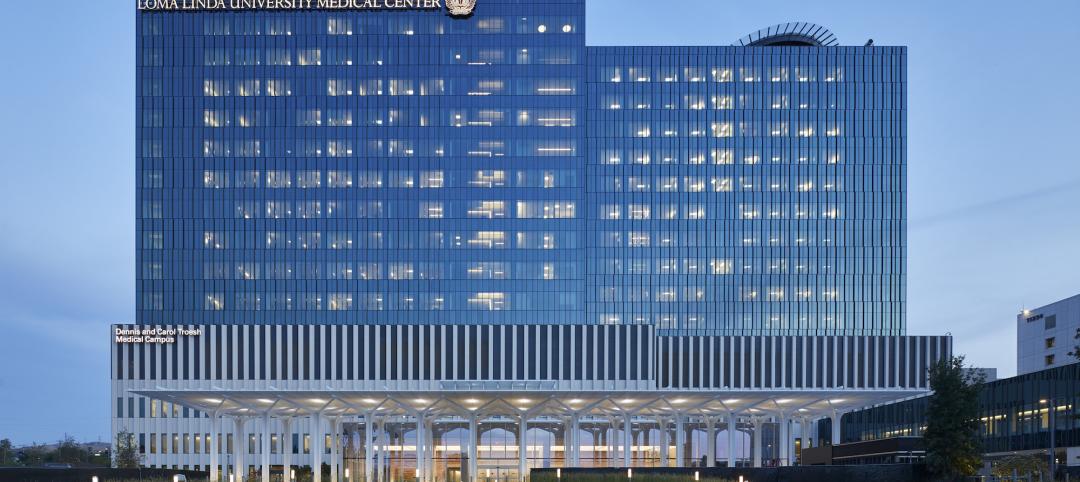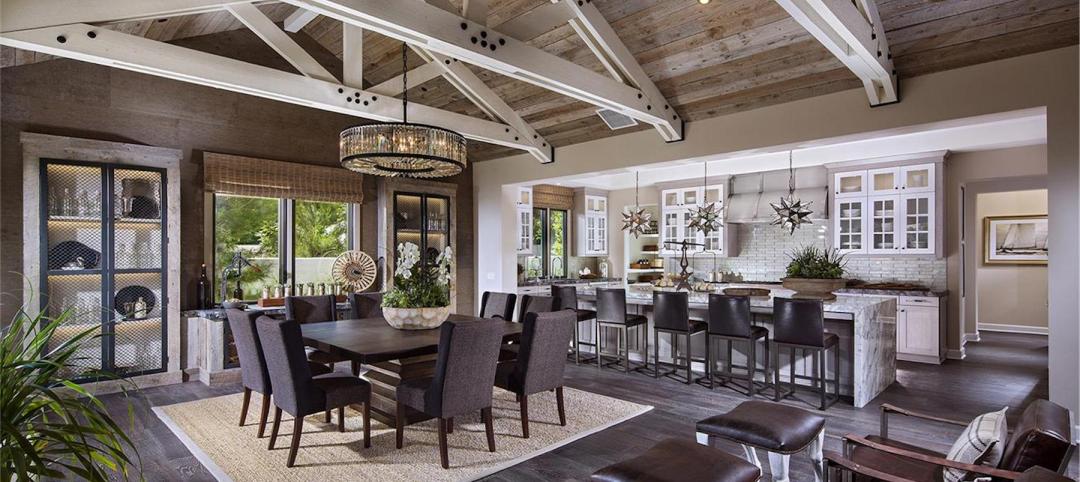California is a breeding ground for building information modeling and integrated project delivery. Major healthcare owners such as Sutter Health and Kaiser Permanente have reaped huge savings from using BIM in the design stage and co-locating their Building Teams early in the process. These efforts pale in comparison to the massive scale of BIM and integrated delivery requirements of the Los Angeles Community College District.
LACCD is currently undergoing a $6 billion construction program on all nine of its campuses throughout Los Angeles County, the most populous county in the U.S. (2010 Census: 9,818,605). To win any of the design-build contracts for new buildings or retrofits, Building Teams must agree to a rigorous BIM program that demands compliance with strict rules on workflow, information sharing, and early design collaboration. The requirements are spelled out in considerable detail. A typical example: “For Spatial Coordination, BIM Facilitator will integrate the design discipline and trade-specific models into a consolidated 3D-model using coordination software.”
Under LACCD’s BIM/IPD procedures, Building Teams must name a lead facilitator to coordinate BIM workflow on behalf of the architect, engineer, or design-build contractor for the entire duration of the project. There are specific requirements for shared data servers and detailed standards for project kickoff orientation meetings. There’s even a stipulation that the designer provide a virtual theater for viewing of 3D models by the entire Building Team.
Design and construction firms that want to work with LACCD must not only agree to the District’s BIM/IPD requirements (http://standards.build-laccd.org/projects/dcs/pub/BIM%20Standards/released/content.html) and modeling standards as a condition of employment, they must also submit to project tracking on LACCD’s BIM project website and agree to turn over their BIM models at the end of construction to LACCD for the owner’s use in managing the facilities.
“We focus on the life cycle of a building,” says Jim Youngblood, the LACCD’s BIM and virtual design and construction manager. “We want anyone working on a project for us to know the importance of the big picture,” Youngblood says that throughout the history of LACCD’s Sustainable Building Program, design and construction consultants have asked him, “Is modeling to this level truly that important and useful to you?” His response: “It is, because we will be using this data for the entire life of these buildings.”
BuildLACCD dates back to 2001, when Los Angeles County voters approved the first of three successive bond measures providing the bulk of the program’s $6 billion in funding. While modernizing the nine colleges was the main priority of the program, LACCD has also used the program to focus on cutting-edge green building techniques, and it has won several awards for its sustainable construction practices. Youngblood says embracing BIM technology is another crucial step toward the LACCD’s sustainability and cost-efficiency goals.
To help design-build teams new to the technology get their footing, BuildLACCD has created its own blog, http://bimlaccd.blogspot.com/, to share success stories, get the word out about BIM workshops run by the LACCD, offer other training opportunities, and share news about of the latest Southern California BIM news.
Youngblood, LACCD BIM manager Michael Cervantes, who oversees the entire LACCD BIM program with assistance from Youngblood, and LACCD BIM designer Giovana Romero are all “active” owners who make a point of attending Building Team meetings for LACCD projects to make sure the BuildLACCD process is being carried out. They recognize, however, that simply requiring BIM and integrated project collaboration is one thing, but following through on such a sophisticated set of requirements is another.
Following are two case studies that give a feel for how BIM is being implemented in LACCD projects.
LOS ANGELES HARBOR COLLEGE—DESIGNING FOR CONSTRUCTABILITY
The Los Angeles office of HGA Architects and Anaheim-based Pinner Construction are the design-build team behind a new 73,767-sf, three-story Science Complex for LA Harbor College. When it’s completed next year, the new complex will consist of two L-shaped, steel-frame structures set perpendicular to each other: a three-story east wing housing laboratories, and a two-story west wing housing lecture halls, classrooms, and offices. The wings are connected via a bridge over a walkway. The L-shaped orientation addresses a primary campus entrance from the parking area, directing pedestrian circulation through the site.
In pursuit of a LEED Platinum rating from the U.S. Green Building Council, HGA and Pinner have developed a strategy that includes self-generation of energy striving to achieve net-zero energy, a 42% energy reduction over California’s Title 24 baseline, 57% water use reduction, and 36% energy self-generation from building-integrated photovoltaic panels. Such a complex building likely would have required BIM and energy modeling in the design stage, even if LACCD didn’t require them.
“It would have been very difficult without Navisworks for clash detection in the first place,” says Matthew Dunbar, HGA’s BIM coordinator on Harbor College. “Pinner Construction’s superintendents went through the Navisworks models with everyone else and flagged areas for constructability and worked with us early in design. That was feedback we wanted and needed.”
Dunbar says the team had frequent meetings via WebEx to go over the shared Navisworks model and got input from subcontractors on how the design model could be used for constructability. He says having a BIM program that forced the entire Building Team to meet and validate their results was helpful in getting the design finalized.
“LACCD was one of the first clients we had that had a standardized process they wanted us to walk through,” he says. “Having done projects before where we had owners who have no idea what we’re doing, or ones who just see dollar signs from BIM, it’s nice to have someone who provides a framework. It was immensely helpful to have this process define what you’re doing.”
James Matson, a principal with HGA’s Los Angeles office, says, “On the design side, the work effort occurs earlier in the process. A well-coordinated team of designers and subcontractors is crucial to making the right design decisions early. This coordinated design effort allows the contractor to begin shop drawings earlier.”
While there was feedback from contractors and subcontractors in the design stage, a new model expressly built for constructability was still needed to go from design to construction.
“We’re adding things that the design side doesn’t think about,” says Roger Charbonneau of AEC Factory, Torrance, Calif., the BIM modeler for Pinner Construction on Harbor College. These neglected components include hangers, bracing, and deck inserts, which AEC Factory added to the construction model and exported out to CAD; from there, the construction team put those components into a Trimble field layout system before construction. “On the design side there are still things that need coordination once the design model is turned over—things like pipe clearances, fireproofing, light-gauge steel,” says Charbonneau. “We’re doing all of that before we get to the field. At the end of the day, the design model and construction model are different.”
Earlier projects at LACCD have even had facilities managers involved. Both mechanical and plumbing subcontractors have done serviceability walks with the facilities system foreman who will ultimately receive the building. This is a system-specific walkthrough, floor by floor, done in Navisworks, Bentley Navigator, or some other BIM navigation program before construction begins.
Theoretically, RFIs and change orders should not occur on LACCD projects, since all Building Team members are coordinating early in the design process. Nonetheless, says Charbonneau, there is still a certain degree of apprehension among Building Team members with making so many crucial decisions so early in the process.
“In design-build we’re on the same side, but that’s not the case in all projects,” Charbonneau says. “Anything we can automate or prefabricate on the construction side is saved money.” The same is not necessarily true on the design side, he says. “In design, those savings aren’t really quantifiable yet. What is saved design time worth?” he asks.
EAST LOS ANGELES COLLEGE—ENCOURAGING STUDENT-FACULTY COLLABORATION
HGA and Pinner’s latest project for the LACCD is the Student Success and Retention Center, a 130,000-sf, $55 million, five-story classroom, office, and language lab building for East Los Angeles College. It consolidates nine departments into a flexible learning environment that encourages collaborative student-faculty interaction while incorporating sustainable strategies to achieve LEED Gold and net-zero energy consumption. Design was recently completed; the scheduled opening is early 2014.
A key to winning this project was keeping the entire HGA/Pinner design-build team together, including subcontractors. The collaboration and early modeling efforts that were pioneered on Harbor College paid off on this project. “Everyone comes back into place and is more efficient,” says HGA’s Dunbar. “We knew the LACCD process better on this one, and that’s really a roadmap for all these projects.” The HGA/Pinner team is competing for a third LACCD project.
“An owner is forcing its teams to work in BIM the way they want them to, and they have $6 billion dollars in new work,” says the AEC Factory’s Charbonneau. “Every player in the team has to be involved. You have a lot of old dogs who don’t want to change, but if they’re on one of these projects they have to. The high-performance team is really hitting its stride on East LA College.” BD+C
BD+C Contributing Editor Jeff “BIMBoy” Yoders blogs on BIM and related design/construction IT topics at www.BDCnetwork.com
Related Stories
Market Data | Oct 12, 2022
ABC: Construction Input Prices Inched Down in September; Up 41% Since February 2020
Construction input prices dipped 0.1% in September compared to the previous month, according to an Associated Builders and Contractors analysis of U.S. Bureau of Labor Statistics’ Producer Price Index data released today.
Hotel Facilities | Oct 12, 2022
Global hotel chain citizenM opens its first Chicago property and its fifth of the year
citizenM, a global chain of affordable luxury hotels, has opened its first Chicago property—its fifth opening of 2022.
Standards | Oct 11, 2022
Peter Templeton named new USGBC and GBCI president and CEO
The U.S. Green Building Council (USGBC) and Green Business Certification Inc. (GBCI) appointed Peter Templeton as president and CEO.
Legislation | Oct 10, 2022
Chicago’s updated building energy code provides incentives for smart HVAC, water appliances
The Chicago City Council recently passed the 2022 Chicago Energy Transformation Code that is intended to align with the city’s goal of reducing carbon emissions by 62% from 2017 levels by 2040.
Contractors | Oct 7, 2022
Nonresidential construction spending down 0.4% in August, says ABC
National nonresidential construction spending was down 0.4% in August, according to an Associated Builders and Contractors analysis of data published today by the U.S. Census Bureau.
Multifamily Housing | Oct 7, 2022
Design for new Ft. Lauderdale mixed-use tower features sequence of stepped rounded volumes
The newly revealed design for 633 SE 3rd Ave., a 47-story, mixed-use tower in Ft. Lauderdale, features a sequence of stepped rounded volumes that ease the massing of the tower as it rises.
Giants 400 | Oct 6, 2022
Top 115 Healthcare Sector Contractors + CM Firms for 2022
Turner Construction, Brasfield & Gorrie, DPR Construction, and JE Dunn Construction top the ranking of the nation's largest healthcare sector contractors and construction management (CM) firms for 2022, as reported in Building Design+Construction's 2022 Giants 400 Report. Note: This ranking factors all healthcare sector work, including hospitals, outpatient facilities, and medical office buildings.
Giants 400 | Oct 6, 2022
Top 90 Healthcare Sector Engineering + EA Firms for 2022
Jacobs, AECOM, WSP, and IMEG Corp. head the ranking of the nation's largest healthcare sector engineering and engineering/architecture (EA) firms for 2022, as reported in Building Design+Construction's 2022 Giants 400 Report. Note: This ranking factors all healthcare sector work, including hospitals, outpatient facilities, and medical office buildings.
Giants 400 | Oct 6, 2022
Top 170 Healthcare Sector Architecture + AE Firms for 2022
HDR, CannonDesign, HKS, and Stantec top the ranking of the nation's largest healthcare sector architecture and architecture/engineering (AE) firms for 2022, as reported in Building Design+Construction's 2022 Giants 400 Report. Note: This ranking factors all healthcare sector work, including hospitals, outpatient facilities, and medical office buildings.
Designers / Specifiers / Landscape Architects | Oct 6, 2022
DAHLIN announces acquisition of Design Line Interiors
DAHLIN Architecture | Planning | Interiors announced today that it is expanding its interiors capabilities with the acquisition of Del Mar, California-based Design Line Interiors.

















